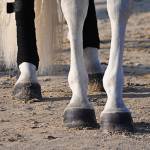Tiludronate: Off-Label Use Common in Large-Scale Study

In the first large-scale study of its kind, veterinarians demonstrated the efficacy of a bisphosphonate drug called tiludronate for managing a wide range of musculoskeletal problems in horses.* Further, tiludronate had “excellent tolerance,” with a satisfactory safety profile, according to the researchers.
Tiludronate slows bone breakdown by inhibiting osteoclasts, cells responsible for bone resorption. Approved for the control of clinical signs of navicular syndrome in horses, studies also show tiludronate benefits horses with bone spavin, spinal osteoarthritis, and bone resorption secondary to limb immobilization.
“Due to the perceived benefits of tiludronate in those conditions, veterinarians also use tiludronate off-label for a variety of other musculoskeletal disorders. However, the efficacy of this off-label use was not known,” explained Kathleen Crandell, Ph.D., a nutritionist for Kentucky Equine Research.
To determine the effectiveness of the medication’s off-label use, data were retrospectively reviewed from two veterinary hospitals that treated 1,804 horses with tiludronate. Safety data were collected, and performance changes were based on improvement in lameness score using the five-point scale put forth by the American Association of Equine Practitioners. A horse’s performance at six and twelve months after treatment was compared to its performance six months prior to treatment.
Tiludronate was administered by a slow, 45-minute intravenous infusion at the recommended dose of 1 mg/kg. Adverse effects were observed in only 0.9% of the horses, with mild colic being the most common. No evidence of kidney disease or failure—a complication previously reported following tiludronate administration—was reported in this study.
Efficacy was assessed based on two criteria: (1) change in lameness during the study period, and (2) performance before and after treatment.
- Follow-up data were available for 343 of the 1,804 treated horses. Of those, only 305 horses were lame at the time of initial presentation, and 80% had a 1.5-grade lameness or higher on the five-point scale. Thirty days after treatment, 47% of treated horses were sound, and 52% were sound one year following treatment.
- Performance data were available for 129 horses. Ninety-three (72%) were back in competition six months after tiludronate administration, and 84% were competing at the same or higher level than six months prior to treatment. One year after treatment, 69% of treated horses were still competing, and 82% were competing at a similar or higher level than six months prior to treatment.
Despite this promising data, several points should be considered when evaluating this study. First, only 18.7% of the 343 horses with evaluable follow-up data were diagnosed with navicular syndrome, which is the only condition for which tiludronate is currently approved. While data also support using tiludronate for two other conditions (bone spavin, spinal osteoarthritis), only 39% of the treated horses were diagnosed with these conditions.
“This means that the bulk of the horses being treated with tiludronate in this study were being treated off-label. Those horses had ‘articular affections,’ arthropathies, suspensory lesions and other soft tissue injuries, bone contusions, cyst-like lesions, and fractures,” Crandell explained.
Second, horses were administered tiludronate over 45 minutes despite the manufacturer’s recommendation for administering this medication over 90 minutes.
Third, 95.7% of the tiludronate injections in this study were preceded by an injection of a nonsteroidal anti-inflammatory drug (NSAID), usually flunixin meglumine. Simultaneous use of NSAIDs and tiludronate is contraindicated by the manufacturer. According to one manufacturer’s technical bulletin, “concurrent use of NSAIDs with tiludronate may increase the risk of renal toxicity and acute renal failure.”
“Finally, many horses were treated with tiludronate more than once during the study period. Specifically, 2,497 injections were performed in the 1,804 horses. The majority of horses (76%) received only one injection, but some were given up to nine separate injections,” she explained.
In sum, these data show that tiludronate is being used off-label, often in conjunction with NSAIDs, and in untested treatment protocols involving multiple injections.
Horse owners have other ways to support the skeletal health of their horses. “Supplementing horses’ diets with Triacton offers another way to support healthy bones, especially in times of convalescence, such as during stall rest. This product contains BMC, a novel source of highly digestible calcium, and delivers bone-building chelated minerals and vitamins, including magnesium, boron, silicone, iodine, zinc, and manganese, as well as vitamins A, C, D, and K,” Crandell said.
*Tischmacher, A., S. Wilford, K. Allen, R.D. Mitchell, T. Parkin, and J.-M. Denoix. 2022. Retrospective analysis of the use of tiludronate in equine practice: Safety on 1804 horses, efficacy on 343 horses. Journal of Equine Veterinary Science:104007.








